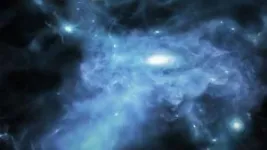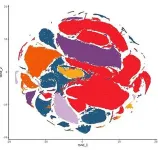(Press-News.org) Using the James Webb Space Telescope, University of Copenhagen researchers have become the first to see the formation of three of the earliest galaxies in the universe, more than 13 billion years ago. The sensational discovery contributes important knowledge about the universe and is now published in the prestigious journal Science.
For the first time in the history of astronomy, researchers at the Niels Bohr Institute have witnessed the birth of three of the universe's absolute earliest galaxies, somewhere between 13.3 and 13.4 billion years ago.
The discovery was made using the James Webb Space Telescope, which brought these first 'live observations' of formative galaxies down to us here on Earth.
Through the telescope, researchers were able to see signals from large amounts of gas that accumulate and accrete onto a mini-galaxy in the process of being built. While this is how galaxies are formed according to theories and computer simulations, it had never actually been witnessed.
"You could say that these are the first 'direct' images of galaxy formation that we’ve ever seen. Whereas the James Webb has previously shown us early galaxies at later stages of evolution, here we witness their very birth, and thus, the construction of the first star systems in the universe," says Assistant Professor Kasper Elm Heintz from the Niels Bohr Institute, who led the new study.
Today, the study has been published in the esteemed scientific journal Science. Link to paper: http://www.science.org/doi/10.1126/science.adj0343
Galaxies born shortly after the Big Bang
The researchers estimate the birth of the three galaxies to have occurred roughly 400-600 million years after the Big Bang, the explosion that began it all. While that sounds like a long time, it corresponds to galaxies forming during the first three to four percent of the universe's 13.8-billion-year overall lifetime.
Shortly after the Big Bang, the universe was an enormous opaque gas of hydrogen atoms – unlike today, where the night sky is speckled with a blanket of well-defined stars.
"During the few hundred million years after the Big Bang, the first stars formed, before stars and gas began to coalesce into galaxies. This is the process that we see the beginning of in our observations," explains Associate Professor Darach Watson.
The birth of galaxies took place at a time in the history of the universe known as the Epoch of Reionization, when the energy and light of some of the first galaxies broke through the mists of hydrogen gas.
It is precisely these large amounts of hydrogen gas that the researchers captured using the James Webb Space Telescope’s infrared vision. This is the most distant measurement of the cold, neutral hydrogen gas, which is the building block of the stars and galaxies, discovered by scientific researchers to date.
Adds to the understanding of our origins
The study was conducted by Kasper Elm Heintz, in close collaboration with, among others, research colleagues Darach Watson, Gabriel Brammer and PhD student Simone Vejlgaard from the Cosmic Dawn Center at the University of Copenhagen’s Niels Bohr Institute – a center whose stated goal is to investigate and understand the dawn of the universe. This latest result brings them much closer to doing just that.
The research team has already applied for more observation time with the James Webb Space Telescope, with hopes of expanding upon their new result and learning more about the earliest epoch in the formation of galaxies.
"For now, this is about mapping our new observations of galaxies being formed in even greater detail than before. At the same time, we are constantly trying to push the limit of how far out into the universe we can see. So, perhaps we’ll reach even further," says Simone Vejlgaard.
According to the researcher, the new knowledge contributes to answering one of humanity’s most basic questions.
"One of the most fundamental questions that we humans have always asked is: 'Where do we come from?'. Here, we piece together a bit more of the answer by shedding light on the moment that some of the universe’s first structures were created. It is a process that we’ll investigate further, until hopefully, we are able to fit even more pieces of the puzzle together," concludes Associate Professor Gabriel Brammer.
The study was conducted by researchers Kasper E. Heintz, Darach Watson, Gabriel Brammer, Simone Vejlgaard, Anne Hutter, Victoria B. Strait, Jorryt Matthee, Pascal A. Oesch, Pall Jakobsson, Nial R. Tanvir, Peter Laursen, Rohan P. Naidu, Charlotte A. Mason, Meghana Killi, Intae Jung, Tiger Yu-Yang Hsiao, Abdurro'uf, Dan Coe, Pablo Arrabal Haro, Steven L. Finkelstein, & Sune Toft.
The Danish portion of the research is funded by the Danish National Research Foundation and the Carlsberg Foundation.
HOW THEY DID IT
Researchers were able to measure the formation of the universe’s first galaxies by using sophisticated models of how light from these galaxies was absorbed by the neutral gas located in and around them. This transition is known as the Lyman-alpha transition.
By measuring the light, the researchers were able to distinguish gas from the newly formed galaxies from other gas. These measurements were only possible thanks to the James Webb Space Telescope’s incredibly sensitive infrared spectrograph capabilities.
ABOUT THE EARLY UNIVERSE
The universe began its “life” about 13.8 billion years ago in an enormous explosion – the Big Bang. The event gave rise to an abundance of subatomic particles such as quarks and electrons. These particles aggregated to form protons and neutrons, which later coalesced into atomic nuclei. Roughly 380,000 years after the Big Bang, electrons began to orbit atomic nuclei, and the simplest atoms of the universe gradually formed.
The first stars were formed after a few hundred million years. And within the hearts of these stars, the larger and more complex atoms that we have around us were formed.
Later, stars coalesced into galaxies. The oldest galaxies known to us were formed about 3-400 million years after the Big Bang. Our own solar system came into being about 4.6 billion years ago – more than 9 billion years after the Big Bang.
Contact:
Kasper Elm Heintz
Assistant Professor
Cosmic Dawn Center
Niels Bohr Institute
University of Copenhagen
keheintz@nbi.ku.dk
+45 23 82 40 56
Michael Skov Jensen
Journalist and team coordinator
The Faculty of Science
University of Copenhagen
msj@science.ku.dk
+ 45 93 56 58 97
END
Birth of universe’s earliest galaxies observed for first time
Using the James Webb Space Telescope, University of Copenhagen researchers have become the first to see the formation of three of the earliest galaxies in the universe, more than 13 billion years ago
2024-05-23
ELSE PRESS RELEASES FROM THIS DATE:
New approach to Epstein-Barr virus and resulting diseases
2024-05-23
The Epstein-Barr virus can cause a spectrum of diseases, including a range of cancers. Emerging data now show that inhibition of a specific metabolic pathway in infected cells can diminish latent infection and therefore the risk of downstream disease, as reported by researchers from the University of Basel and the University Hospital Basel in the journal Science.
Exactly 60 years ago, pathologist Anthony Epstein and virologist Yvonne Barr announced the discovery of a virus that has carried their names ever since. The Epstein-Barr virus (EBV) made scientific history as the first virus proven to cause cancer in humans. Epstein and Barr isolated the pathogen, ...
Tracking the cellular and genetic roots of neuropsychiatric disease
2024-05-23
New Haven, Conn. – A new analysis has revealed detailed information about genetic variation in brain cells that could open new avenues for the targeted treatment of diseases such as schizophrenia and Alzheimer’s disease.
The findings, reported May 23 in Science, were the result of a multi-institutional collaboration known as PsychENCODE, founded in 2015 by the National Institutes of Health, which seeks new understandings of genomic influences on neuropsychiatric disease. The study was published alongside related studies in Science, Science Advances, and Science ...
Pioneering new study uncovers insights into PTSD & major depressive disorder
2024-05-23
AUSTIN, Texas — Stress-related disorders like post-traumatic stress disorder and clinical depression are complex conditions influenced by both genetics and our environment. Despite significant research, the molecular mechanisms behind these disorders have remained elusive. However, researchers at Dell Medical School at The University of Texas at Austin have broken new ground with a study that sheds light on the intricate differences occurring in the brains of people with PTSD and depression compared to neurotypical controls. The study, published this week in Science, could provide potential avenues for novel therapeutics and biomarkers.
“Understanding why some people develop ...
Two new studies by Mount Sinai researchers in science offer key insights into the origins and potential treatment of mental health disorders
2024-05-23
Working under the umbrella of the PsychENCODE Consortium, the mental health research project established in 2015 by the National Institutes of Health, a team of Mount Sinai scientists has uncovered important new insights into the molecular biology of neuropsychiatric disease through two new studies published in a special issue of Science on Friday, May 24. These investigations, conducted with colleagues from other major research centers, involve the largest single-cell analysis to date of the brains of people with schizophrenia, and a first-of-its-kind ...
Sequencing of the developing human brain uncovers hundreds of thousands of new gene transcripts
2024-05-23
A team led by researchers at UCLA and the University of Pennsylvania has produced a first-of-its kind catalog of gene-isoform variation in the developing human brain. This novel dataset provides crucial insights into the molecular basis of neurodevelopmental and psychiatric brain disorders and paves the way for targeted therapies.
The research, published in Science, also details how transcript expression varies by cell type and maturity, finding that changing gene-isoform expression levels can help ...
Carnegie Mellon University researchers to tackle carbon use, sustainability through NSF expeditions in computing awards
2024-05-23
Researchers from Carnegie Mellon University's School of Computer Science will contribute to two multi-institution research initiatives aimed at reducing the use of carbon and creating sustainable computing.
The projects recently received funding through the U.S. National Science Foundation's (NSF) Expeditions in Computing Awards program, which is providing $36 million to three projects selected for their potential to revolutionize computing and make significant impacts toward reducing the carbon footprint of the lifecycle of computers. The ...
USDA-NIFA grant supports microwave tech to zap weed seeds
2024-05-23
By John Lovett
University of Arkansas System Division of Agriculture
FAYETTEVILLE, Ark. — It’s not just for burritos and popcorn. Microwave technology is also being tested as a new tool to destroy weed seeds and decrease herbicide use.
Scientists and engineers with the Arkansas Agricultural Experiment Station are investigating the use of 915 MHz microwaves to neutralize a variety of weed seeds underground. The study is supported by a nearly $300,000 Agriculture and Food Research Initiative grant from the U.S. Department of Agriculture’s National Institute of Food and Agriculture, with additional support ...
Research spotlight: AI enabled body composition analysis predicts outcomes for patients with lung cancer treated with immunotherapy
2024-05-23
Tafadzwa Chaunzwa, MD, a researcher in the Artificial Intelligence in Medicine (AIM) Program at Mass General Brigham and a senior resident physician at the Harvard Radiation Oncology Program, is the lead author of a paper published in JAMA Oncology. Chaunzwa and senior author Hugo Aerts, PhD, director of the AIM Program, and associate professor at Harvard University, shared highlights from their paper.
How would you summarize your study for a lay audience?
As treatments like immunotherapy improve cancer survival rates, there is a growing need for clinical decision-support tools that predict treatment response ...
Silky shark makes record breaking migration
2024-05-23
In a recent study, researchers from the Charles Darwin Foundation (CDF), in collaboration with the Guy Harvey Research Institute (GHRI) and Save Our Seas Foundation Shark Research Center (SOSF-SRC) at Nova Southeastern University in Florida, and the Galapagos National Park Directorate (GNPD) have documented the most extensive migration ever recorded for a silky shark (Carcharhinus falciformis), revealing critical insights into the behavior of this severely overfished species and emphasizing the urgent need for cooperative international management measures to prevent further population declines.
The ...
Sexual parasitism helped anglerfish invade the deep sea during a time of global warming
2024-05-23
Members of the vertebrate group including anglerfishes are unique in possessing a characteristic known as sexual parasitism, in which males temporarily attach or permanently fuse with females to mate. Now, researchers reporting in the journal Current Biology on May 23 show that sexual parasitism arose during a time of major global warming and rapid transition for anglerfishes from the ocean floor to the deep, open sea.
The findings have implications for understanding evolution and the effects that global warming may have in the deep sea, according to the researchers.
“Our results show how the ...
LAST 30 PRESS RELEASES:
Research suggests nationwide racial bias in media reporting on gun violence
Revealing the cell’s nanocourier at work
Health impacts of nursing home staffing
Public views about opioid overdose and people with opioid use disorder
Age-related changes in sperm DNA may play a role in autism risk
Ambitious model fails to explain near-death experiences, experts say
Multifaceted effects of inward foreign direct investment on new venture creation
Exploring mutations that spontaneously switch on a key brain cell receptor
Two-step genome editing enables the creation of full-length humanized mouse models
Pusan National University researchers develop light-activated tissue adhesive patch for rapid, watertight neurosurgical sealing
Study finds so-called super agers tend to have at least two key genetic advantages
Brain stimulation device cleared for ADHD in the US is overall safe but ineffective
Scientists discover natural ‘brake’ that could stop harmful inflammation
Tougher solid electrolyte advances long-sought lithium metal batteries
Experts provide policy roadmap to reduce dementia risk
New 3D imaging system could address limitations of MRI, CT and ultrasound
First-in-human drug trial lowers high blood fats
Decades of dredging are pushing the Dutch Western Scheldt Estuary beyond its ecological limits
A view into the innermost workings of life: First scanning electron microscope with nanomanipulator inaugurated in hesse at Goethe University
Simple method can enable early detection and prevention of chronic kidney disease
S-species-stimulated deep reconstruction of ultra-homogeneous CuS nanosheets for efficient HMF electrooxidation
Mechanical and corrosion behavior of additively manufactured NiTi shape memory alloys
New discovery rewrites the rules of antigen presentation
Researchers achieve chain-length control of fatty acid biosynthesis in yeast
Water interactions in molecular sieve catalysis: Framework evolution and reaction modulation
Shark biology breakthrough: Study tracks tiger sharks to Maui mating hub
Mysterious iron ‘bar’ discovered in famous nebula
World-first tool reduces harmful engagement with AI-generated explicit images
Learning about public consensus on climate change does little to boost people’s support for action, study shows
Sylvester Cancer Tip Sheet for January 2026
[Press-News.org] Birth of universe’s earliest galaxies observed for first timeUsing the James Webb Space Telescope, University of Copenhagen researchers have become the first to see the formation of three of the earliest galaxies in the universe, more than 13 billion years ago








